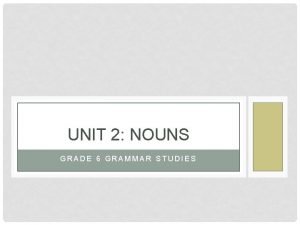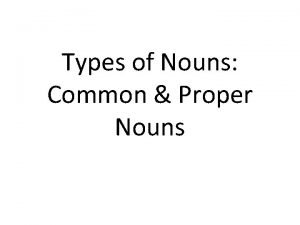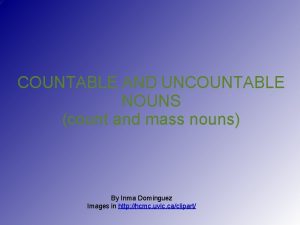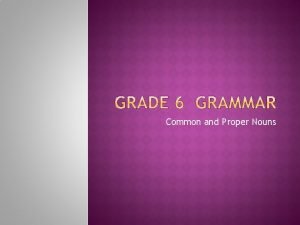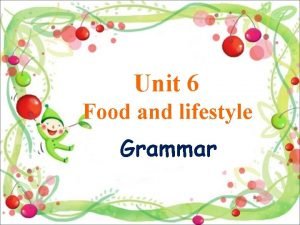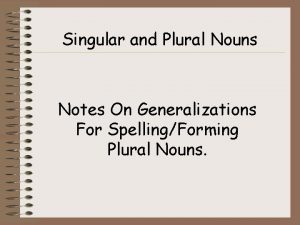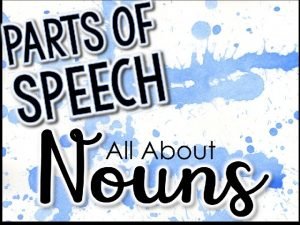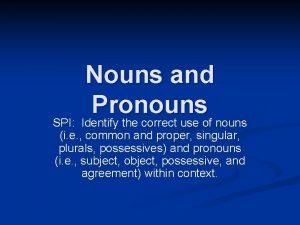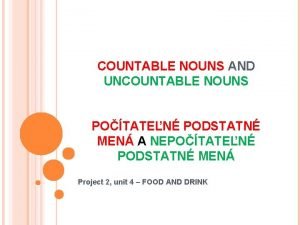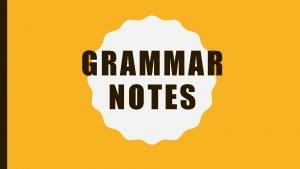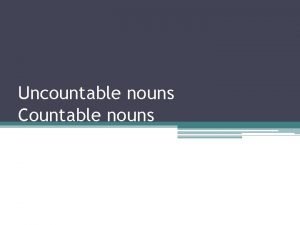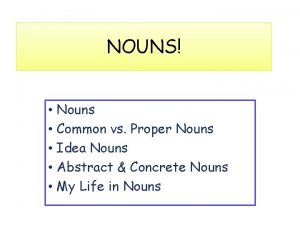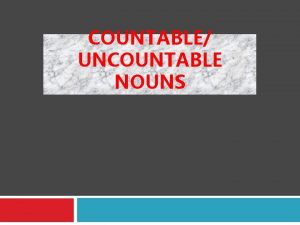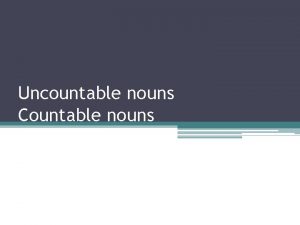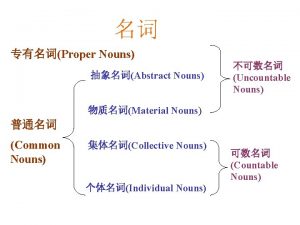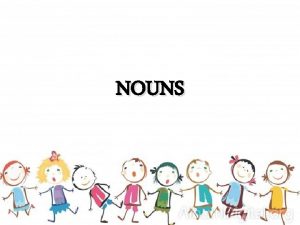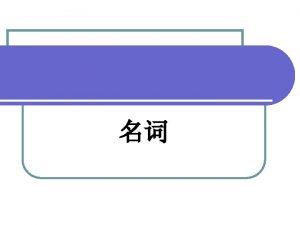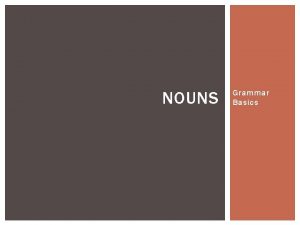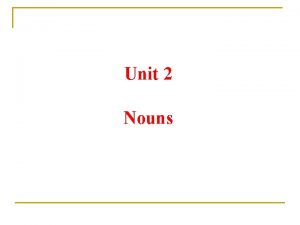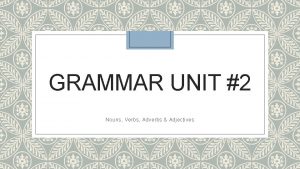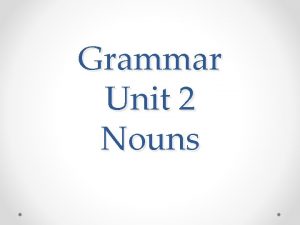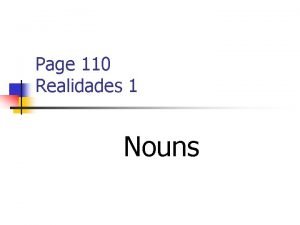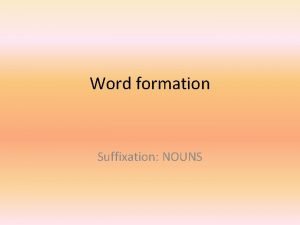UNIT 2 NOUNS GRADE 6 GRAMMAR STUDIES UNIT
















- Slides: 16

UNIT 2: NOUNS GRADE 6 GRAMMAR STUDIES

UNIT OVERVIEW • • What is a noun? Compound Nouns Common & proper nouns Concrete & abstract nouns Capitalization of nouns Forming plural nouns Forming possessive nouns Noun / adjective agreement

LESSON 2. 1: WHAT IS A NOUN? • A NOUN is a part of speech that names a person, place, object/thing, an idea or a feeling. • A COMPOUND NOUN is a noun made up of two or more words used together as a single noun. • A COLLECTIVE NOUN is a word that names a group People • • • Jackie Robinson girl father goalie Mrs. Sullivan class Places • • • Object/Thing Idea Examples of Nouns • book • freedom town Cohasset library airport Los Angeles Derby Street Shoppes • • • pencil puppy Inside Out • • bravery Saturday Feeling • • happiness joy anger fear

LESSON 2. 1 PRACTICE Directions: Identify the nouns in the following sentences. Write “COMPOUND” above any compound nouns. 1. The team had to travel to Norwell for their game. 2. The coach announced the starting line-up in the locker room. 3. The referees blew their whistles to signal the end of warmups. 4. Basketball is an exciting sport. 5. Our tournament will be held at Boston College next Saturday.

LESSON 2. 2: CONCRETE/ABSTRACT NOUNS • Nouns can either be concrete or abstract. • Abstract nouns names things that you can think about but cannot see or touch. • Examples: faith, democracy, Buddhism, sadness • Concrete nouns names things that can be seen or touched. • Examples: water, Statue of Liberty, fruit, tree

LESSON 2. 2 PRACTICE Directions: Identify whether the following nouns are concrete or abstract. T. V. happiness brother New Years Eve New York City snow fear i. Pad jewelry laws sunglasses banana Starbucks

LESSON 2. 3 COMMON/PROPER NOUNS • In addition to concrete and abstract, nouns can also be common or proper. • Common nouns are any nouns that do not name a specific person, place, thing, idea or feeling. • Common nouns are not capitalized. • Proper nouns are any nouns that name a specific person, place, thing, idea or feeling. • Proper nouns are capitalized.

COMMON/PROPER NOUNS Common • • • teacher holiday boat book restaurant Proper • • • Mrs. Jewell Labor Day Titanic The Hunger Games Cohasset House of Pizza Notice the capitalization of the common and proper nouns.

LESSON 2. 3 PRACTICE Directions: Identify each of the following underlined nouns in these sentences as common or proper. 1. The Adventures of Huckleberry Finn is a classic American book. 2. Marine biologists who work at the Cape Cod Canal research underwater sea life. 3. The New England Patriots were the 2015 Superbowl champions.

LESSON 2. 4 APPOSITIVES • An appositive is a noun that follows another noun. It renames or describes the noun it follows. Usually appositives are set off by commas. • Example: My oldest sister, Alicia, will be at basketball practice until 6: 00 am. • Example: The character, Sabrina, is Josie’s favorite. • Sometimes, appositives can be phrases. • Example: Jamaica, a popular island for tourists, is in the Caribbean Sea. • Example: The North Sea, an arm of the Atlantic Ocean, is rich in fish, natural gas, and oil.

PRACTICE 2. 4 Directions: Add commas to set off each appositive or appositive phrase. Underline the noun and circle the appositive or appositive phrase it tells more about. 1. The whole class has read the novel Old Yeller. 2. Shana Alexander a former editor of a popular magazine was the main speaker at the conference. 3. The Galapagos Islands a group of volcanic islands in the Pacific Ocean were named for the Spanish word that means “tortoise. ” 4. Rubber an elastic substance quickly restores itself to its original size and shape. 5. My friend Imelda is teaching me how to make empanadas.

LESSON 2. 5 FORMING POSSESSIVE NOUNS • The possessive form of a noun expresses possession, or ownership. • Examples: Kathleen’s desk horses’ manes anybody’s guess children’s toys • To form the possessive case, you will need to know whether the noun is SINGULAR (one) or PLURAL (MANY), and whether the noun ends in –s.

FORMING THE POSSESSIVE Singular Nouns Plural Nouns • To form the possessive of a singular noun, add an s to the end of the word. • To form the possessive case of a plural noun that does not end in –s, add an apostrophe and an –s. (‘s) Examples: A boy’s cap The baby’s toy Charles’s opinion • Examples: Mice’s tracks Women’s shoes Teeth’s enamel

PRACTICE: FORMING POSSESSIVE OF SINGULAR AND PLURAL NOUNS (NOT ENDING IN –S) Directions: Identify the noun that needs to be in the possessive case. Then, correct the noun to be in the possessive case. 1. The Prado in Madrid, Spain, is one of the worlds greatest museums. 2. Velazquezs painting is known in English as The Maids of Honor. 3. Typically, mens feet are larger than womens.

FORMING THE POSSESSIVE Forming the possessive of a plural noun ending in -s To form the possessive of a plural noun ending in –s, only add an appostrophe to the end of the word. Cats’ basket Brushes’ bristles Four days’ delay The Carsons’ bungalow

PRACTICE: FORMING POSSESSIVE OF PLURAL NOUNS ENDING IN -S Directions: Identify the noun that needs to be in the possessive case. Then, correct the noun to be in the possessive case. 1. My two cousins softball game is this Saturday. 2. After playing soccer, my legs muscles are sore. 3. Have you washed our horses manes? 4. The classes average is an 87%. 5. My glasses rim is broken.
 Unit 2 nouns lesson 7 nouns proper and common answer key
Unit 2 nouns lesson 7 nouns proper and common answer key Countable and uncountable table
Countable and uncountable table Shelf is common or proper noun
Shelf is common or proper noun Countable and uncountable
Countable and uncountable Paragraph on noun
Paragraph on noun Write a c for countable nouns or a u for uncountable nouns
Write a c for countable nouns or a u for uncountable nouns Singular and plural subject list
Singular and plural subject list Pig common or proper noun
Pig common or proper noun Abrigo es singular o plural
Abrigo es singular o plural Proper noun for girl
Proper noun for girl Countable and uncountable nouns vysvetlenie
Countable and uncountable nouns vysvetlenie Notes on nouns
Notes on nouns Paradigm shift from women studies to gender studies
Paradigm shift from women studies to gender studies How to convert right linear grammar to left linear grammar
How to convert right linear grammar to left linear grammar The characteristics of traditional grammar
The characteristics of traditional grammar Unrestricted grammar example
Unrestricted grammar example Right linear grammar
Right linear grammar
